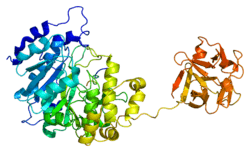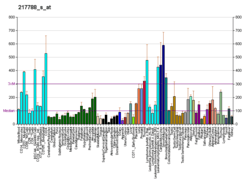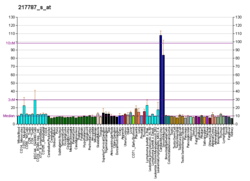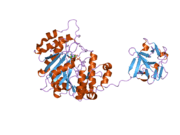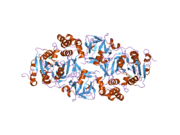GALNT2
Polypeptide N-acetylgalactosaminyltransferase 2 is an enzyme that in humans is encoded by the GALNT2 gene.[3][4][5]
This gene encodes polypeptide N-acetylgalactosaminyltransferase 2, a member of the GalNAc-transferases family. This family transfers an N-acetyl galactosamine to the hydroxyl group of a serine or threonine residue in the first step of O-linked oligosaccharide biosynthesis. The localization site of this particular enzyme is preponderantly the trans-Golgi.[6] Individual GalNAc-transferases have distinct activities and initiation of O-glycosylation in a cell is regulated by a repertoire of GalNAc-transferases.[5]
References
- ↑ "Human PubMed Reference:".
- ↑ "Mouse PubMed Reference:".
- ↑ Bennett EP, Weghuis DO, Merkx G, van Kessel AG, Eiberg H, Clausen H (Jul 1998). "Genomic organization and chromosomal localization of three members of the UDP-N-acetylgalactosamine: polypeptide N-acetylgalactosaminyltransferase family". Glycobiology. 8 (6): 547–55. PMID 9592121. doi:10.1093/glycob/8.6.547.
- ↑ White T, Bennett EP, Takio K, Sorensen T, Bonding N, Clausen H (Dec 1995). "Purification and cDNA cloning of a human UDP-N-acetyl-alpha-D-galactosamine:polypeptide N-acetylgalactosaminyltransferase". J Biol Chem. 270 (41): 24156–65. PMID 7592619. doi:10.1074/jbc.270.41.24156.
- 1 2 "Entrez Gene: GALNT2 UDP-N-acetyl-alpha-D-galactosamine:polypeptide N-acetylgalactosaminyltransferase 2 (GalNAc-T2)".
- ↑ "African Swine Fever Virus Causes Microtubule-Dependent Dispersal of trans-Golgi Network" (PDF).
Further reading
- Bennett EP, Hassan H, Clausen H (1996). "cDNA cloning and expression of a novel human UDP-N-acetyl-alpha-D-galactosamine. Polypeptide N-acetylgalactosaminyltransferase, GalNAc-t3.". J. Biol. Chem. 271 (29): 17006–12. PMID 8663203. doi:10.1074/jbc.271.29.17006.
- Wandall HH, Hassan H, Mirgorodskaya E, et al. (1997). "Substrate specificities of three members of the human UDP-N-acetyl-alpha-D-galactosamine:Polypeptide N-acetylgalactosaminyltransferase family, GalNAc-T1, -T2, and -T3.". J. Biol. Chem. 272 (38): 23503–14. PMID 9295285. doi:10.1074/jbc.272.38.23503.
- Müller S, Goletz S, Packer N, et al. (1997). "Localization of O-glycosylation sites on glycopeptide fragments from lactation-associated MUC1. All putative sites within the tandem repeat are glycosylation targets in vivo.". J. Biol. Chem. 272 (40): 24780–93. PMID 9312074. doi:10.1074/jbc.272.40.24780.
- Röttger S, White J, Wandall HH, et al. (1998). "Localization of three human polypeptide GalNAc-transferases in HeLa cells suggests initiation of O-linked glycosylation throughout the Golgi apparatus.". J. Cell. Sci. 111 (1): 45–60. PMID 9394011.
- Mattu TS, Pleass RJ, Willis AC, et al. (1998). "The glycosylation and structure of human serum IgA1, Fab, and Fc regions and the role of N-glycosylation on Fc alpha receptor interactions.". J. Biol. Chem. 273 (4): 2260–72. PMID 9442070. doi:10.1074/jbc.273.4.2260.
- Iwasaki H, Zhang Y, Tachibana K, et al. (2003). "Initiation of O-glycan synthesis in IgA1 hinge region is determined by a single enzyme, UDP-N-acetyl-alpha-D-galactosamine:polypeptide N-acetylgalactosaminyltransferase 2.". J. Biol. Chem. 278 (8): 5613–21. PMID 12438318. doi:10.1074/jbc.M211097200.
- Strausberg RL, Feingold EA, Grouse LH, et al. (2003). "Generation and initial analysis of more than 15,000 full-length human and mouse cDNA sequences". Proc. Natl. Acad. Sci. U.S.A. 99 (26): 16899–903. PMC 139241
 . PMID 12477932. doi:10.1073/pnas.242603899.
. PMID 12477932. doi:10.1073/pnas.242603899. - Marcos NT, Cruz A, Silva F, et al. (2003). "Polypeptide GalNAc-transferases, ST6GalNAc-transferase I, and ST3Gal-transferase I expression in gastric carcinoma cell lines". J. Histochem. Cytochem. 51 (6): 761–71. PMID 12754287. doi:10.1177/002215540305100607.
- Kinarsky L, Suryanarayanan G, Prakash O, et al. (2004). "Conformational studies on the MUC1 tandem repeat glycopeptides: implication for the enzymatic O-glycosylation of the mucin protein core". Glycobiology. 13 (12): 929–39. PMID 12925576. doi:10.1093/glycob/cwg109.
- Ota T, Suzuki Y, Nishikawa T, et al. (2004). "Complete sequencing and characterization of 21,243 full-length human cDNAs". Nat. Genet. 36 (1): 40–5. PMID 14702039. doi:10.1038/ng1285.
- Gerhard DS, Wagner L, Feingold EA, et al. (2004). "The Status, Quality, and Expansion of the NIH Full-Length cDNA Project: The Mammalian Gene Collection (MGC)". Genome Res. 14 (10B): 2121–7. PMC 528928
 . PMID 15489334. doi:10.1101/gr.2596504.
. PMID 15489334. doi:10.1101/gr.2596504. - Gregory SG, Barlow KF, McLay KE, et al. (2006). "The DNA sequence and biological annotation of human chromosome 1". Nature. 441 (7091): 315–21. PMID 16710414. doi:10.1038/nature04727.
This article is issued from
Wikipedia.
The text is licensed under Creative Commons - Attribution - Sharealike.
Additional terms may apply for the media files.
